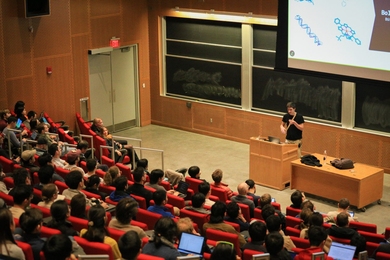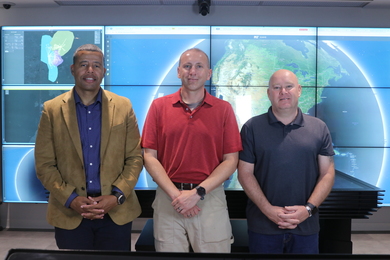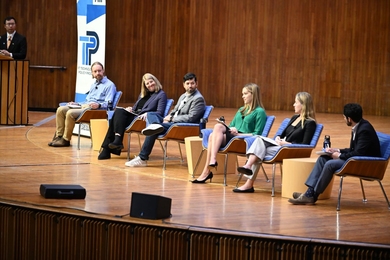Undergraduates at MIT have been known to spend countless hours conceiving and creating marketable innovations in labs and classrooms. Sometimes, however, they may struggle with turning their ideas into commercial reality.
“One reason is that these students tend to focus all their time on inventing, as opposed to exploring the journey that awaits a startup founder,” says Ken Zolot, a seasoned entrepreneur and a senior lecturer in the Department of Electrical Engineering and Computer Science.
For the past four years, Zolot has led course 6.933 (The Founder’s Journey), in which engineering undergraduates — along with some students from other disciplines — focus on entrepreneurship and business strategy. Along the way, Zolot says, the course aims to “demystify and inspire entrepreneurship” so students will be equipped to continue with entrepreneurial pursuits — and maybe bring their inventions to fruition.
MIT offers many other entrepreneurship classes for undergraduates — many of them in the MIT Sloan School of Management — but Zolot’s course is uniquely geared toward students studying engineering and the sciences.
For the course, student teams develop startup concepts, refining those ideas through a variety of class projects throughout the semester. They also receive advice from other MIT professors, guest entrepreneurs and others. For their final projects, the teams must pitch their startup ideas to visiting judges, including venture capitalists.
The gradual learning process, which mimics the early stages of building a company, is especially valuable for MIT’s engineering students, says Zolot, who has co-founded several companies, including Egenera and Rethink Robotics.
“Many engineering students came to MIT hoping to learn what it takes to turn an idea into a reality,” he says. “They’ve stumbled upon a great innovation and want to be the next Steve Jobs. So the course answers their initial questions: ‘Who do you need to team up with?’ ‘How do you validate an idea?’ ‘Is entrepreneurship something you even want to do?’”
In the course’s relatively short history, a few successful companies have arisen from student concepts conceived and developed in 6.933 — such as Hipmunk, a popular travel webpage, and Rest Devices, a company that designs health-monitoring clothing.
“Engineering students may come to MIT with different skills than, say, our MBA students — who are already looking to do business courses and don’t need to be inspired into entrepreneurship — but they have great ideas,” Zolot says. “Not only do we want to teach our engineers how to build great things, but we also want for them to experience taking a core technology and transforming into something that has meaningful impact on the world.”
‘Their own clubhouse’
It’s not only the course’s content that’s beneficial for students; being plugged into a community of engineering entrepreneurs also pays dividends, Zolot says. “It’s good for engineers to have their own clubhouse,” he says. “It gives them a chance to meet like-minded co-founders of startups and be inspired by role models.”
Additionally, the course offers fledgling entrepreneurs a controlled and risk-free environment for product and startup experimentation, Zolot says. “It’s like a safe sandbox where they can test out ideas and meet some of those inevitable early failures,” he says.
In that way, Zolot says, students learn valuable entrepreneurial skills, primarily iteration and improvisation — conducting experiments with their inventions and refining as they go.
“It’s about seeing design as a living process, with multiple stakeholders,” Zolot says. “Some engineers mistakenly think they should work diligently behind closed doors devising the perfect plan, then release that plan to the world.”
But that’s not how startups rise, Zolot says. “I want them instead to launch lots of small experiments, get out in the world, figure out what assumptions they can easily test, and make data-driven decisions that direct each stage of the design of the startup,” he says.
That philosophy seems to have resonated with Latif Alam, a senior majoring in economics. “If it’s one thing that this course taught me, it’s coming up with a product to commercialize quickly,” says Alam, who was part of Dolphin Health, a team working on a smartphone app that tracks users’ vital signs and other measures of health. “It’s about coming up with the simplest viable product and getting it into customers’ hands.”
Guest speakers over the course’s five-year history have included Drew Houston, founder and CEO of Dropbox; Khan Academy founder Sal Khan; Chris Hughes, co-founder of Facebook; Robin Chase, co-founder of Zipcar; Scott Kirsner, who writes the “Innovation Economy” column for The Boston Globe; and Dharmesh Shah, co-founder of Hubspot, among dozens of others.
Beginning the journey
This semester’s students demonstrated their newfound business knowledge during their final pitches to visiting judges: They enthusiastically fleshed out their startups’ projected revenues, manufacturing costs, and potential competitors and corporate partnerships, among other things.
During the class, junior Claire O’Connell worked on ChariTweet — a startup that aims to connect Twitter accounts to charities for easy donations. She said the course sparked her entrepreneurial spirit not only because of its curriculum, but also because of the mentors she met along the way — namely, Joe Chung, co-founder and managing director of Red Star Ventures.
“It’s definitely one of the most valuable classes I’ve taken,” says O’Connell, who is majoring in brain and cognitive sciences. “I’ve been exposed to so many people I wouldn’t have [met] otherwise. I almost feel like I’m now part of the Boston entrepreneurship community.”
Echoing her classmate’s sentiments was Elizabeth Phillips, a senior majoring in chemical engineering, who worked on Sense-a-Mold, which aims to manufacture food-storage containers equipped with sensors to detect spoiled food.
Phillips may not pursue her startup — she has graduate school and other interests on her plate — but she says the course was inspiring for her. “I felt like I left each class wanting to go out and start a business,” she says.
Those who wish to further develop their startups can enroll in a companion course, 6.S078 (Entrepreneurship Project), that Zolot co-teaches with David Gifford, a professor of electrical engineering and computer science. In that class, students receive help from outside entrepreneurs and venture capitalists — who may also invest in their startups.
“One reason is that these students tend to focus all their time on inventing, as opposed to exploring the journey that awaits a startup founder,” says Ken Zolot, a seasoned entrepreneur and a senior lecturer in the Department of Electrical Engineering and Computer Science.
For the past four years, Zolot has led course 6.933 (The Founder’s Journey), in which engineering undergraduates — along with some students from other disciplines — focus on entrepreneurship and business strategy. Along the way, Zolot says, the course aims to “demystify and inspire entrepreneurship” so students will be equipped to continue with entrepreneurial pursuits — and maybe bring their inventions to fruition.
MIT offers many other entrepreneurship classes for undergraduates — many of them in the MIT Sloan School of Management — but Zolot’s course is uniquely geared toward students studying engineering and the sciences.
For the course, student teams develop startup concepts, refining those ideas through a variety of class projects throughout the semester. They also receive advice from other MIT professors, guest entrepreneurs and others. For their final projects, the teams must pitch their startup ideas to visiting judges, including venture capitalists.
The gradual learning process, which mimics the early stages of building a company, is especially valuable for MIT’s engineering students, says Zolot, who has co-founded several companies, including Egenera and Rethink Robotics.
“Many engineering students came to MIT hoping to learn what it takes to turn an idea into a reality,” he says. “They’ve stumbled upon a great innovation and want to be the next Steve Jobs. So the course answers their initial questions: ‘Who do you need to team up with?’ ‘How do you validate an idea?’ ‘Is entrepreneurship something you even want to do?’”
In the course’s relatively short history, a few successful companies have arisen from student concepts conceived and developed in 6.933 — such as Hipmunk, a popular travel webpage, and Rest Devices, a company that designs health-monitoring clothing.
“Engineering students may come to MIT with different skills than, say, our MBA students — who are already looking to do business courses and don’t need to be inspired into entrepreneurship — but they have great ideas,” Zolot says. “Not only do we want to teach our engineers how to build great things, but we also want for them to experience taking a core technology and transforming into something that has meaningful impact on the world.”
‘Their own clubhouse’
It’s not only the course’s content that’s beneficial for students; being plugged into a community of engineering entrepreneurs also pays dividends, Zolot says. “It’s good for engineers to have their own clubhouse,” he says. “It gives them a chance to meet like-minded co-founders of startups and be inspired by role models.”
Additionally, the course offers fledgling entrepreneurs a controlled and risk-free environment for product and startup experimentation, Zolot says. “It’s like a safe sandbox where they can test out ideas and meet some of those inevitable early failures,” he says.
In that way, Zolot says, students learn valuable entrepreneurial skills, primarily iteration and improvisation — conducting experiments with their inventions and refining as they go.
“It’s about seeing design as a living process, with multiple stakeholders,” Zolot says. “Some engineers mistakenly think they should work diligently behind closed doors devising the perfect plan, then release that plan to the world.”
But that’s not how startups rise, Zolot says. “I want them instead to launch lots of small experiments, get out in the world, figure out what assumptions they can easily test, and make data-driven decisions that direct each stage of the design of the startup,” he says.
That philosophy seems to have resonated with Latif Alam, a senior majoring in economics. “If it’s one thing that this course taught me, it’s coming up with a product to commercialize quickly,” says Alam, who was part of Dolphin Health, a team working on a smartphone app that tracks users’ vital signs and other measures of health. “It’s about coming up with the simplest viable product and getting it into customers’ hands.”
Guest speakers over the course’s five-year history have included Drew Houston, founder and CEO of Dropbox; Khan Academy founder Sal Khan; Chris Hughes, co-founder of Facebook; Robin Chase, co-founder of Zipcar; Scott Kirsner, who writes the “Innovation Economy” column for The Boston Globe; and Dharmesh Shah, co-founder of Hubspot, among dozens of others.
Beginning the journey
This semester’s students demonstrated their newfound business knowledge during their final pitches to visiting judges: They enthusiastically fleshed out their startups’ projected revenues, manufacturing costs, and potential competitors and corporate partnerships, among other things.
During the class, junior Claire O’Connell worked on ChariTweet — a startup that aims to connect Twitter accounts to charities for easy donations. She said the course sparked her entrepreneurial spirit not only because of its curriculum, but also because of the mentors she met along the way — namely, Joe Chung, co-founder and managing director of Red Star Ventures.
“It’s definitely one of the most valuable classes I’ve taken,” says O’Connell, who is majoring in brain and cognitive sciences. “I’ve been exposed to so many people I wouldn’t have [met] otherwise. I almost feel like I’m now part of the Boston entrepreneurship community.”
Echoing her classmate’s sentiments was Elizabeth Phillips, a senior majoring in chemical engineering, who worked on Sense-a-Mold, which aims to manufacture food-storage containers equipped with sensors to detect spoiled food.
Phillips may not pursue her startup — she has graduate school and other interests on her plate — but she says the course was inspiring for her. “I felt like I left each class wanting to go out and start a business,” she says.
Those who wish to further develop their startups can enroll in a companion course, 6.S078 (Entrepreneurship Project), that Zolot co-teaches with David Gifford, a professor of electrical engineering and computer science. In that class, students receive help from outside entrepreneurs and venture capitalists — who may also invest in their startups.






